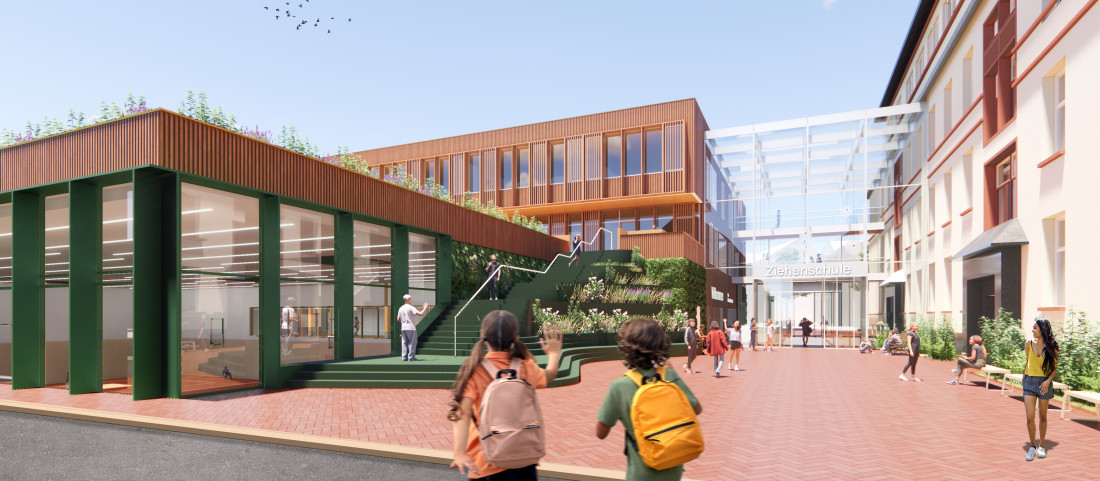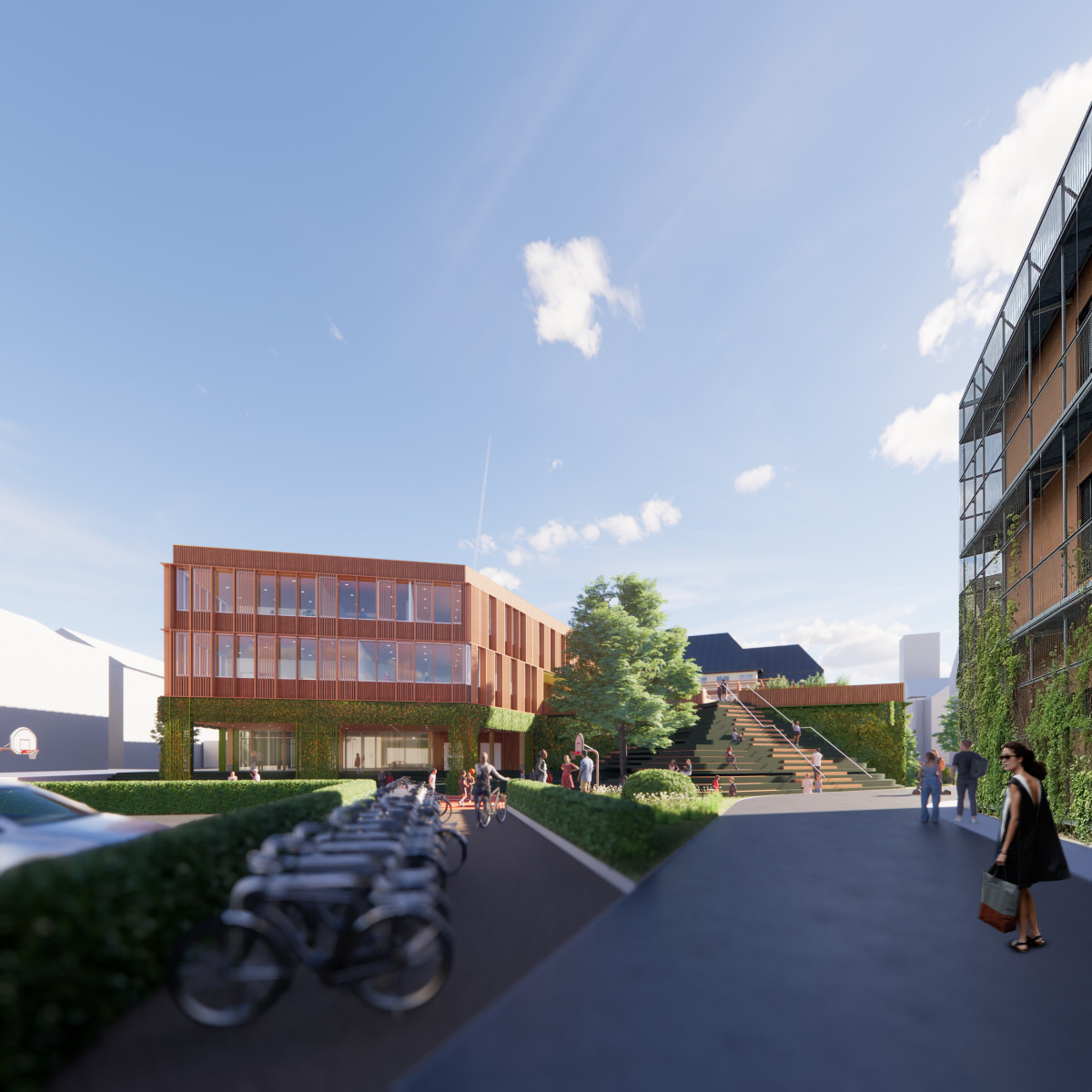The Ziehenschule is a ‘Gymnasium’ secondary school on Frankfurt's green northern edge, housed in a listed historical building from 1914. The building has been extended twice: once in the 1960s, with a modernist wing and a sports hall in pre-fab materials, and once in 2011, with a separate annex for the oldest students. Despite these extensions, the school - which currently has about 1,250 pupils - struggles with a lack of space. Moreover, the existing complex no longer meets the educational requirements of today: there are no meeting spaces or flexibly deployable classrooms, and the school lacks a central 'heart'. Therefore, the Ziehenschule decided to organise an invited competition for a new wing, which is to replace the extension from the 1960s. Because of our extensive experience with school design in the Netherlands, atelier PRO was asked to participate in this competition. Our ambition was to design a respectful addition to the monumental structure, with spaces where people can meet, feel safe and learn from and with each other.
A new connection between buildings
In our design, we positioned the new wing between the listed historical building and the detached annexe of the upper school; its outline refers to the surrounding structures, integrating the new extension within the urban context. By positioning the new wing at the edge of the plot we created room for a sports hall, but also made sure that the distance with the historical school building was retained. As a result, the monumental structure is still the most iconic part of the Ziehenschule, and will continue to define the image of the school. Because of its shape and location on the school grounds, the new wing acts as a connecting link between the existing buildings.
Bridging the old and the new
The new wing is also physically connected to the historical school building, by means of a transparent glass volume. The main entrance to the school is housed in this volume. To make for a smooth transition, the floor heights in the new wing are adjusted to those in the existing building; this creates the possibility to connect both buildings, with bridges running through the transparant volume. This direct connection between the old and the new aims to promote deepened interaction between departments and learning clusters.
The atrium as a ‘heart’
In the new wing, ‘space to meet' take centre stage - both in the literal and the figurative sense. Centrally located in the new volume is a light-flooded atrium, which spans the full height of the building; a sweeping staircase serves as an eye-catcher as well as a meeting point. The media library and the student café - which overlooks the sports hall - are located directly adjacent to the atrium. This interconnected series of social spaces serves as the new heart, the centre of the school. This ‘heart’ is surrounded by floors with open and flexible floor plans, which provide room for spontaneous interactions; there are areas for group study and for concentrated learning, but also areas where pupils can relax and take breaks together.
Social interactions and security
The division of functions in both the new and the old building has been thought out carefully: the central areas, which are intended for intensive and general use, are located on the lower floors; areas that require a higher degree of concentration and differentiation have been situated on the upper floors. The classrooms are grouped in learning clusters centred around open study spaces; where possible, walking routes are routed around the learning clusters; this makes it possible to use the open study spaces as flexible teaching areas, in addition to the classrooms. All classrooms of the lower school* are concentrated on the second floor of the new wing, somewhat shielded from school life; thus, this floor forms a secure home base for the youngest pupils.
Respectful renovation
The old building will be completely renovated, without compromising the existing structure. Stairs and sanitary facilities will remain in place, while technical areas will be added. To make room for new learning programmes and open study spaces, we have opened up walls and combined classrooms where possible. We have also made creative use of the possibilities that the monumental structure offered. For instance, the former sports hall was reused for the music rooms. Its location in the basement, separated from the other classrooms, eliminates noise pollution almost automatically; this meant no cost-intensive acoustic measures were needed. The rooms on the top floor of the historical school building, with their high vaulted ceilings, are ideal for art classes. The monumental auditorium has kept its original function as a multifunctional space for exams and school events. The old building will become the domain of the middle school pupils, for whom we deigned new study spaces between the staircases on every floor.
Connections between inside and outside
On the outside, the new wing presents itself as a layered volume, designed with respect for the existing building. For the façade, we applied impregnated prefabricated hardwood elements and aluminium windows. The walls on the ground floor are clad with trelliswork, allowing for a green façade; the upper floors are finished in red-hued wood - a reference to the red sandstone cornices and window frames of the monumental school building. The semi-underground sports hall has been outfitted with a walkable roof which serves as an extension of the schoolyard; this also offers the possibility to create an additional entrance here. An inviting staircase and decked landscape lead from the street level to the roof, and provide an attractive place for pupils to spend break time. Thus, our design creates ‘spaces to meet’ both inside and outside.
Sustainability
The Ziehenschule was designed as a hybrid building, using carbon-neutral wood and concrete. The basement and staircases are executed in concrete, the floors in a wooden frame construction. Prefab ribbed wooden ceilings with integrated sound insulation are used to span the classrooms; the wood is left in plain sight, providing a high-end look-and-feel and an improvement of the indoor climate.
The advantage of this building method is that all internal divisions can be constructed as non-load-bearing walls, which allows for flexible and easily adaptable floor plans. It also reduces the construction time, which - given the school's inner-city location - is financially advantageous. In addition, the use of wood leads to lower loads on the concrete foundation, which can therefore be dimensioned more compactly; compared to a concrete construction, this leads to a lower overall use of resources. In addition, we want also to investigate the possibility to reuse the concrete from the demolished building. This will save raw materials and decrease transport mileage, further reducing the building's carbon footprint.
*NB: In Germany, children go to primary school when they are 6 years old, and proceed to secondary school after a 4-year course. This means that the age of pupils in lower Gymnasium ('Lehrgemeinschaft 1') is between 10 and 13, those in middle school ('Lehrgemeinschaft 2') between 14 and 16, and those in upper school ('Sekundarstufe II') between 17 and 19.



